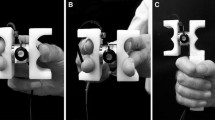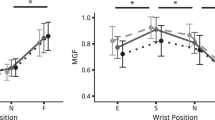Abstract
The extrinsic digit muscles naturally couple wrist action and grip force in prehensile tasks. We explored the effects of wrist position on the steady-state grip force and grip-force change during imposed changes in the grip aperture [apparent stiffness (AS)]. Subjects held an instrumented handle steady using a prismatic five-digit grip. The grip aperture was changed slowly, while the subjects were instructed not to react voluntarily to these changes. An increase in the aperture resulted in an increase in grip force, and its contraction resulted in a proportional drop in grip force. The AS values (between 4 and 6 N/cm) were consistent across a wide range of wrist positions. These values were larger when the subjects performed the task with eyes open as compared to eyes-closed trials. They were also larger for trials that started from a larger initial aperture. After a sequence of aperture increase and decrease to the initial width, grip force dropped by about 25 % without the subjects being aware of this. We interpret the findings within the referent configuration hypothesis of grip-force production. The results support the idea of back-coupling between the referent and actual digit coordinates. According to this idea, the central nervous system defines referent coordinates for the digit tips, and the difference between the referent and actual coordinates leads to force production. If actual coordinates are not allowed to move to referent ones, referent coordinates show a relatively slow drift toward the actual ones.






Similar content being viewed by others
References
Ambike SS, Paclet F, Latash ML, Zatsiorsky VM (2013) Grip-force modulation in multi-finger prehension during wrist flexion and extension. Exp Brain Res 227:509–522. doi:10.1007/s00221-013-3527-z
Aoki T, Latash ML, Zatsiorsky VM (2007) Adjustments to local friction in multifinger prehension. J Mot Behav 39:276–290. doi:10.3200/JMBR.39.4.276-290
Baweja HS, Patel BK, Martinkewiz JD, Vu J, Christou EA (2009) Removal of visual feedback alters muscle activity and reduces force variability during constant isometric contractions. Exp Brain Res 197:35–47. doi:10.1007/s00221-009-1883-5
Bernstein N (1967) The co-ordination and regulation of movements. Pergamon, Oxford
Brand P, Hollister A (1999) Clinical mechanics of the hand. Mosby Year Book, St. Louis
Burstedt MKO, Flanagan JR, Johansson RS (1999) Control of grasp stability in humans under different frictional conditions during multidigit manipulation. J Neurophysiol 82:2393–2405
Feldman A (1966) Functional tuning of the nervous system with control of movement of maintainence of a steady posture—II. Controllable parameters of the muscle. Biophysika 11:565–578
Feldman AG (1986) Once more for the equilibrium-point hypothesis (lambda-model) for motor control. J Mot Behav 18:17–54
Feldman AG (2011) Space and time in the context of equilibrium-point theory. Wiley Cogn Sci 2:287–304
Feldman AG, Levin MF (1996) Grasping cerebellar function depends on our understanding the principles of sensorimotor integration: the frame of reference hypothesis. Behav Brain Sci 19:442–445
Feldman A, Orlovsky G (1972) The influence of different descending systems on the tonic stretch reflex in the cat. Exp Neurol 37:481–494
Flanagan J, Tresilian J (1994) Grip-load force coupling: a general control strategy for transporting objects. J Exp Psychol Hum Percept Perform 20:944–957
Flanagan J, Wing A (1993) Modulation of grip force with load force during point-to-point arm movements. Exp Brain Res 95:131–143
Gao F, Latash ML, Zatsiorsky VM (2005) Internal forces during object manipulation. Exp Brain Res 165:69–83
Jaric S, Collins JJ, Marwaha R, Russell E (2006) Interlimb and within limb force coordination in static bimanual manipulation task. Exp Brain Res 168:88–97. doi:10.1007/s00221-005-0070-6
Johansson RS, Westling G (1984) Roles of glabrous skin receptors and sensorimotor memory in automatic control of precision grip when lifting rougher or more slippery objects. Exp Brain Res 56:550–564
Kerr J, Roth B (1986) Analysis of multifingered hands. Int J Robot Res 4:3–17
Latash ML (1992) Independent control of joint stiffness in the framework of the equilibrium—point hypothesis. Biol Cybern 67:377–384
Latash ML, Zatsiorsky VM (1993) Joint stiffness: myth or reality? Hum Mov Sci 12:653–692
Latash ML, Friedman J, Kim SW, Feldman AG, Zatsiorsky VM (2010) Prehension synergies and control with referent hand configurations. Exp Brain Res 202:213–229. doi:10.1007/s00221-009-2128-3
Lemay MA, Crago PE (1996) A dynamic model for simulating movements of the elbow, forearm, an wrist. J Biomech 29:1319–1330
Martin V, Scholz JP, Schöner G (2009) Redundancy, self-motion, and motor control. Neural Comput 21:1371–1414. doi:10.1162/neco.2008.01-08-698
Mason M, Salisbury J (1985) Robot hands and the mechanics of manipulation. The MIT Press, Cambridge
Matthews P (1959) A study of certain factors influencing the stretch reflex of the decerebrate cat. J Physiol 147:547–564
McMahon T (1984) Muscles, reflexes, and locomotion. Princeton University Press, Princeton
Murray RM, Li Z, Sastry SS (1994) A mathematical introduction to robotic manipulation. CRC Press, Boca Raton
Paclet F (2010) Analyse biomécanique des transferts tendineux de la main (Technique Tsugé). Dissertation, Universite Joseph Fourier
Paclet F, Ambike S, Zatsiorsky VM, Latash ML (in press) Enslaving in a serial chain: interactions between grip force and hand force in isometric conditions. Exp Brain Res. doi:10.1007/s00221-013-3787-7
Parikh PJ, Cole KJ (2012) Handling objects in old age: forces and moments acting on the object. J Appl Physiol 112:1095–1104. doi:10.1152/japplphysiol.01385.2011
Pilon J-F, De Serres SJ, Feldman AG (2007) Threshold position control of arm movement with anticipatory increase in grip force. Exp Brain Res 181:49–67
Platzer W (2004) Color atlas of human anatomy, locomotor system. Thieme, New York
Savescu A, Latash ML, Zatsiorsky VM (2008) A technique to determine friction at the finger tips. J Appl Biomech 24:43–50
Singh T, Zatsiorsky VM, Latash ML (2012) Effects of fatigue on synergies in a hierarchical system. Hum Mov Sci 31:1379–1398. doi:10.1016/j.humov.2012.06.008
Slifkin AB, Vaillancourt DE, Newell KM (2000) Intermittency in the control of continuous force production. J Neurophysiol 84:1708–1718
Slota GP, Latash ML, Zatsiorsky VM (2011) Grip forces during object manipulation: experiment, mathematical model, and validation. Exp Brain Res 213:125–139
Smeets J, Brenner E (1999) A new view on grasping. Mot Control 3:237–271
Vaillancourt DE, Russell DM (2002) Temporal capacity of short-term visuomotor memory in continuous force production. Exp Brain Res 145:275–285. doi:10.1007/s00221-002-1081-1
Van Doren CL (1998) Grasp stiffness as a function of grasp force and finger span. Mot Control 2:352–378
Westling G, Johansson RS (1984) Factors influencing the force control during precision grip. Exp Brain Res 53:277–284
Xu Y, Terekhov AV, Latash ML, Zatsiorsky VM (2012) Forces and moments generated by the human arm: variability and control. Exp Brain Res 223:159–175. doi:10.1007/s00221-012-3235-0
Yoshikawa T, Nagai K (1991) Manipulating and grasping forces in manipulation by multifingered robot hands. IEEE Trans Robot Autom 7:67–77
Zatsiorsky VM (2002) Kinetics of human movement. Human Kinetics
Zatsiorsky VM, Latash ML (2008) Multi-finger prehension: an overview. J Mot Behav 40:446–476
Zatsiorsky VM, Gao F, Latash ML (2006) Prehension stability: experiments with expanding and contracting handle. J Neurophysiol 95:2513–2529. doi:10.1152/jn.00839.2005
Zhang W, Gordon AM, McIsaac TL, Santello M (2011) Within-trial modulation of multi-digit forces to friction. Exp Brain Res 211:17–26. doi:10.1007/s00221-011-2628-9
Acknowledgments
We thank Ms. Kelly Ann Carey for her assistance in data collection. The present work was supported by NIH Grants NS-035032 and AR-048563.
Author information
Authors and Affiliations
Corresponding author
Appendix: Statistical analysis of the unbalanced digit moments
Appendix: Statistical analysis of the unbalanced digit moments
For each trial, the resultant moment of all digits was computed in the handle-fixed reference frame located at point P (Fig. 1). The moment profiles were averaged across the three repetitions for each condition. We analyzed the moment in the grasp plane (M Y ) and the magnitude of the moment vector (|M|). From the averaged moment trajectory for each condition, the following six M Y and |M| values were selected: (1) initial steady-state values (IniSS), (2) the maximum value during the aperture-opening phase (max open), (3) the minimum value during the aperture-opening phase (min open), (4) the maximum value during the aperture-closing phase (max close), (5) the minimum value during the aperture-closing phase (min close), and (6) the final steady-state value (FinSS). Data were pooled across subjects and conditions (wrist position, eyes open/closed, initial aperture size) and subjected to a one-way ANOVA with the factor Epoch (6 levels). Pairwise comparisons were done using Bonferroni corrections.
The results are shown in Fig. 7. The ANOVA showed a significant effect of Epoch for both M Y [F (5,1094) = 37.104, p < 0.01] and |M| [F (5,1094) = 31.395; p < 0.01], and several pairwise comparisons were significant. We summarize the main observations below.
The mean and SD for the unbalanced moment about the handle-fixed Y-axis M Y (black bars) and the magnitude of the net unbalanced moment |M| (white bars) are shown. These variables were analyzed at the following six conditions: (1) initial steady state (IniSS), (2) the maximum during the aperture-opening phase (max open), (3) the minimum during the aperture-opening phase (min open), (4) the maximum during the aperture-closing phase (max close), (5) the minimum during the aperture-closing phase (min close), and (6) the final steady state (FinSS)
-
1.
The initial and final steady-state values were the same for both variables.
-
2.
The moments dropped during the aperture-opening epoch from their initial steady-state values.
-
3.
The moments recovered during the aperture-closing epoch.
-
4.
These changes, although significant, were small. The largest differences between the marginal means for any pair were −33.26 N/mm for M Y and 19.9 N/mm for |M|.
-
5.
The overall means (SD) for the two variables were −50.23 ± 28.2 N/mm for M Y and 60.91 ± 20.9 N/mm for |M|.
We conclude that a consistent, nonzero moment was applied by the digits on the handle to counter the unbalanced external torque. Possible sources of this external torque are the handle weight, since the handle CG is not located at point P (Fig. 1), and cables of the sensors and the laser. In particular, the digits applied a consistent supination moment of about 50 N/mm on the handle.
Rights and permissions
About this article
Cite this article
Ambike, S., Paclet, F., Zatsiorsky, V.M. et al. Factors affecting grip force: anatomy, mechanics, and referent configurations. Exp Brain Res 232, 1219–1231 (2014). https://doi.org/10.1007/s00221-014-3838-8
Received:
Accepted:
Published:
Issue Date:
DOI: https://doi.org/10.1007/s00221-014-3838-8





